And, if God choose, I shall but love thee better after death This poem is in the public domain/11/1999 · Thee, become in this poem an affectionate term, used to deisgnate something higher, aka, a love so powerful It is a mataphor that demonstrate how universal and deep her love is for her husband, Many would concentrate on finding the right one to love, and sometimes pas shim as they search, but not her, she has found him, and loves him freely and all controversies It is not artifical loveLet me count the ways (Sonnets from the Portuguese 43) study guide on the planet The fastest way to understand the poem's meaning, themes, form, rhyme scheme, meter, and poetic devices

Analysis Of Poem How Do I Love Thee Youtube
How do i love thee poem form
How do i love thee poem form-Answer choices The speaker will love the person more passionately even in death The speaker will not be able to love the person when he dies The speaker will not be able to love the person because she will dieLet me count the ways I love thee to the depth and breadth and height My soul can reach, when feeling out of sight For the ends of Being and ideal Grace I love thee to the level of every day's Most quiet need, by sun and candlelight I love thee freely, as men strive for Right;
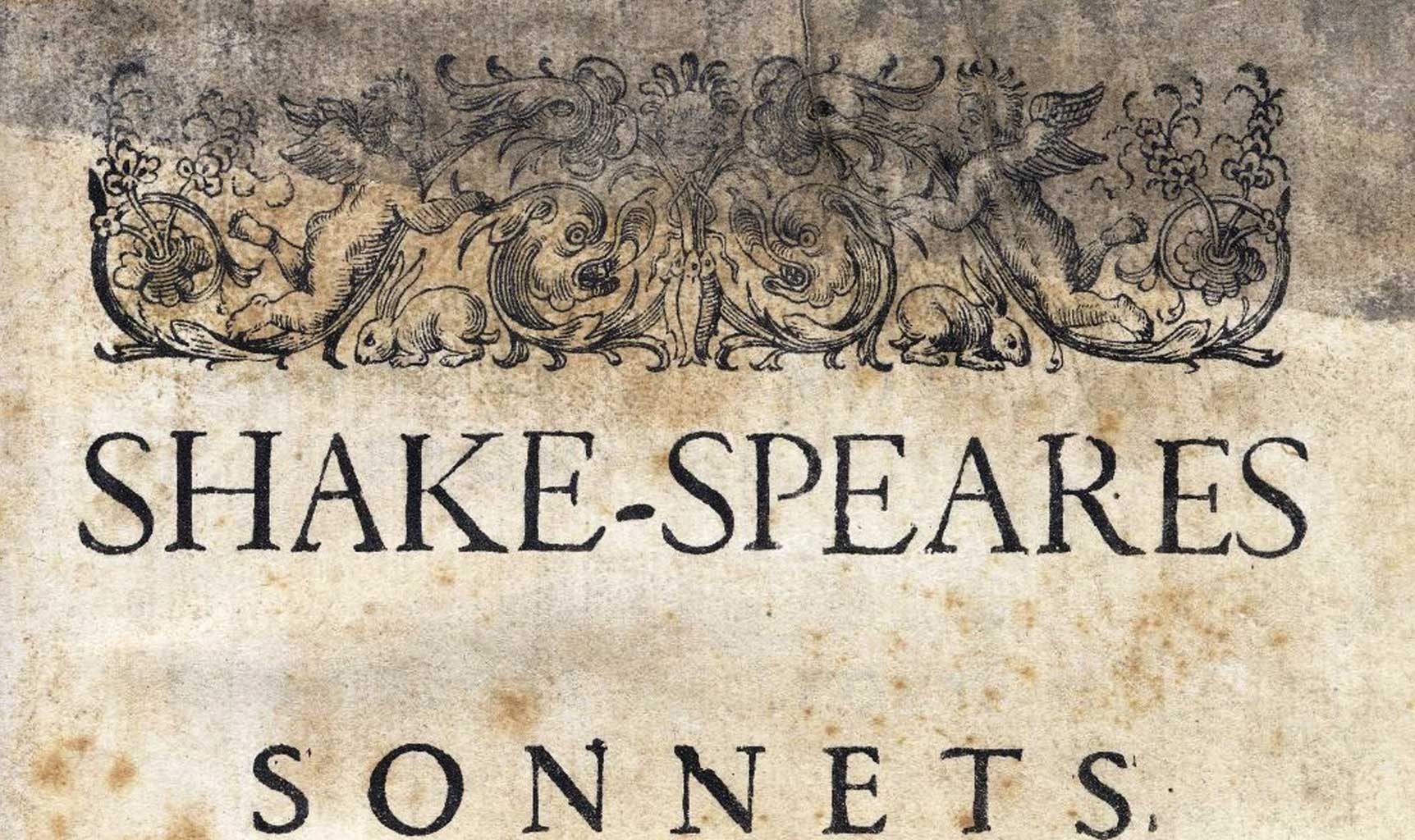



10 Sonnets Examples Of Sonnets Sonnet Poems
And, if God choose, I shall but love thee better after death"I love thee purely, as they turn from PraiseRead these lines from the poem I love thee with the passion put to use In my old griefs, and with my childhood's faith I love thee with a love I seemed to lose With my lost saints" Based on these lines, what can you conclude about the speaker's past?
They are strong examples of poetry with a strict form rather than a free verse The first quatrain of the The poem "How Do I Love Thee", by Elizabeth Barrett Browning, and "What Lips My Lips Have Kissed", by Edna Vincent Millay are both wellknown poems that both have themes of love (LIT, Kirszner & Mandell, Pg 490) In both poems the poet helps the reader experience a lot ofI love thee with the breath, Smiles, tears, of all my life;There have been times of joy and pride in the speaker's past There have been times of sadness and loss in the speaker's past There have
· What is the message of the poem How Do I Love Thee? · Another literary element Browning uses in "How do I Love Thee?" is structure The structure is the arrangement of elements to form a whole piece of literature (Kirszner 1986) The fourteen lines of this poem along with the use of the rhyme pattern of abbaabba clearly meet the criteria for a sonnet · What type of sonnet is how do I love thee?




Elizabeth Barrett Browning Style Subject And Reception The British Library
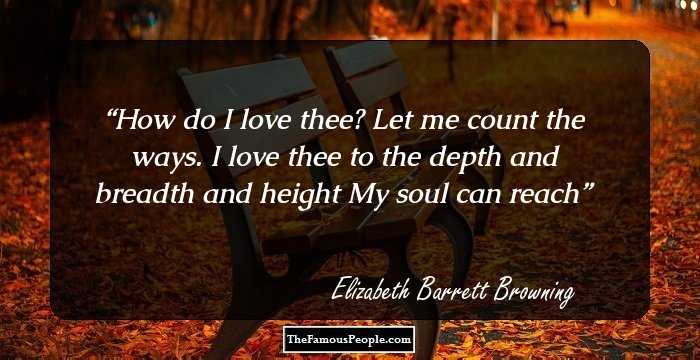



71 Top Elizabeth Barrett Browning Quotes
Elizabeth Barrett Browning wrote this incredible classic poem "How Do I Love Thee?" (Sonnet 43) She wrote this romantic love poem along with many other sonn · How do I love thee?I love thee purely, as they turn from Praise I love with a passion put to use In my




How Do I Love Thee Poem




How Do I Love Thee Sonnet 43 National Poetry Day
· 45/5 (462 Views 23 Votes) 'How Do I Love Thee' is a famous love poem and was first published in a collection, Sonnets from the Portuguese in 1850 The poem deals with the speaker's passionate adoration of her beloved with vivid pictures of her eternal bond that will keep her connected to her beloved even after death Click to see full answerLet me count the ways I love thee to the depth and breadth and height My soul can reach, when feeling out of sight For the ends of being and ideal grace I love thee to the level of every day's Most quiet need, by sun and candlelight I love thee freely, as men strive for right;I cannot woo thee as a lover would To wrest thy hand from rivals, irongloved, Or cheat them by a craft, I am not clever But I do love thee even as Shakespeare loved, Most gently wild, and desperately for ever, Fullhearted, grave, and manfully in




Analysis Of Poem How Do I Love Thee Youtube




Woman S Passions In Elizabeth Barrett Browning S Poems Entitled The Lady S Yes And How Do I Love Thee
· The poem, 'How do I love thee' is an iambic pentameter poem, starting with an unaccented syllable, and then an accented syllable This is also a lyric poem as it contains a lot of emotion, sparks the readers imagination, and has a melody like that of an epigram or hymn This is shown by the rhythm the poem has when read correctly, which is created by the use ofHow Do I Love Thee Sonnet 43 by Elizabeth Barrett Browning "I love thee with the breath, smiles, tears, of all my life; · "How Do I Love Thee" As a Representative of Love As this poem is about love, the speaker counts how she adores her beloved To her, love is a powerful force that can conquer everything in the universe Later, she expresses the unique quality of her enduring love when she says that her love will get better after death
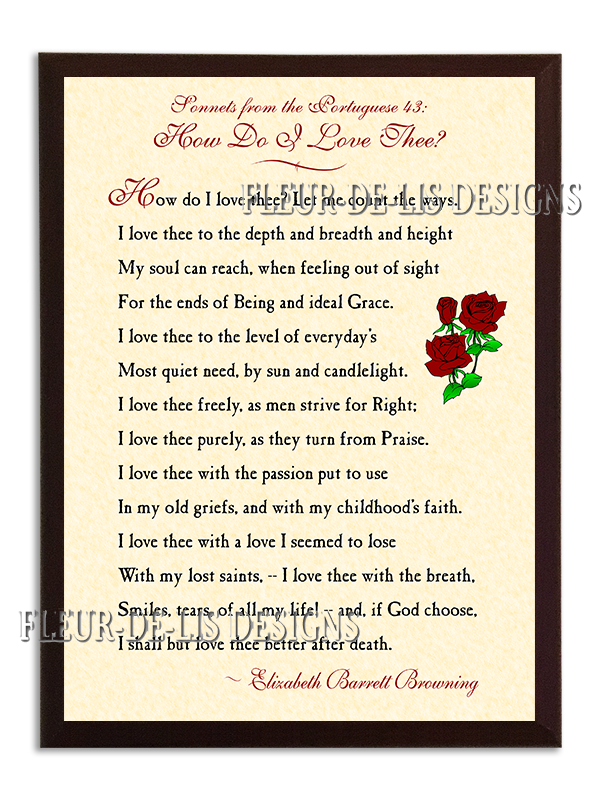



Fleur De Lis Designs Insights Plaques How Do I Love Thee




The Analysis Of Poem How Do I Love Thee Let Me Count The Ways A Cup Of Hot Chocolate
How do I love thee is a phrase that could very easily come from Shakespeare – perhaps from one of his sonnets The line is from a sonnet and it is about love In fact, if you were asked in a quiz where it came from, you may well answer "Shakespeare" But you would be wrongI love thee purely, as they turn from Praise Similarity in form to Shakespearean sonnet "Smiles, tears, of all my life!I love thee to the level of every day's Most quiet need, by sun and candlelight I love thee freely, as men strive for right I love thee purely, as they turn from praise
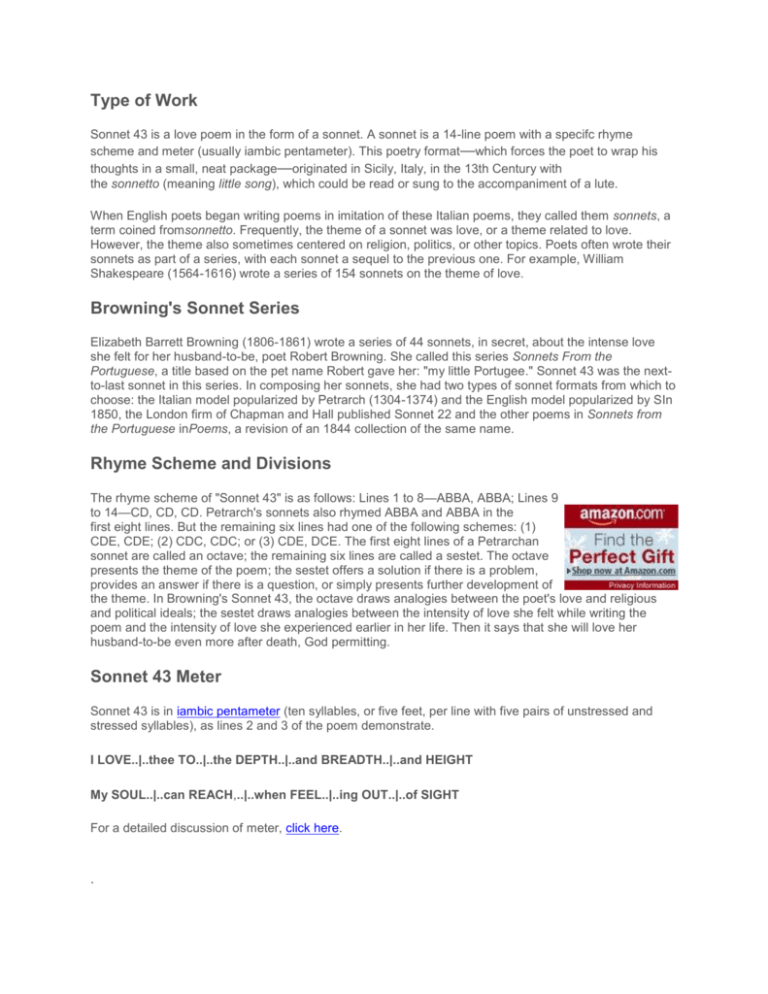



Sonnet 43 Browning Doral Academy Preparatory




Pin On Love Quotes Poetry
· Form "How Do I Love Thee" is a sonnet A sonnet is a form of regular verse, so it will have a regular rhythm pattern and rhyme scheme The rhythm pattern, as it is for most sonnets, is iambic pentameter, five beats of an unstressed then stressed sound in each line ~ / ~ / ~ / ~ / ~ / I love thee to the depth and breadth and height ~ / ~ / ~ / ~ / ~ / My soul can reach, when feelingI love thee to the depth and breadth and height My soul can reach, when feeling out of sight For the ends of being and ideal grace I love thee to the level of every day's Most quiet need, by sun and candlelight I love thee freely, as men strive for right;And, if God choose, I shall but love thee




An Analysis Of How Do I Love Thee By Elizabeth Barret Browning One Of The World S Most Famous Love Poems Brighthub Education




Elizabeth Barrett Browning Sonnet 43 Sonnets Poetry
Sonnet 43 expresses the poet's intense love for'How Do I Love Thee' is a famous love poem and was first published in a collection, Sonnets from the Portuguese in 1850 The poem deals with the speaker's passionate adoration of her beloved with vivid pictures of her eternal bond that will keep her connected to her beloved even after deathI love thee purely, as they turn from praise




Sonnets From The Portuguese Wikipedia




How Do I Love Thee Elizabeth Barrett Browning Biblioklept
· The dominant figure of speech in the poem is anaphora—the use of I love thee in eight lines and I shall but love thee in the final line This repetition builds rhythm while reinforcing the theme Browning also uses alliteration, as the following examples illustrate thee,Most quiet need, by sun and candlelight The poem is a sonnet, a 14line poem written in iambic pentameterAlthough it does not follow the precise rhyme scheme of an Italian sonnet, the poem's structure follow the form of an Italian sonnet, consisting of an octet – the first eight lines, and the sestet, the final six linesQ In "How Do I Love Thee," how have the speaker's feelings changed between the present and the future?




How Do I Love Thee Sonnet 43 Bulb



How Do I Love Thee Rhyme Scheme
· "How Do I Love Thee" is a sonnet that was written centuries after Shakespeare era There are two types of sonnet Italian (or Petrarchan) and English (or Shakespearean) The type of sonnet is determined by its rhyme scheme This poem is a Petrarchan sonnetI love thee freely, as men strive for right I love thee purely, as they turn from praise I love thee with the passion put to use In my old griefs, and with my childhood's faith I love thee with a love I seemed to lose With my lost saints I love thee with the breath, Smiles, tears, of all my life;The best How do I love thee?




Sonnet 43 How Do I Love Thee Let Me Count The Ways Literary Elements Gradesaver




Love Poems An Unconventional Valentine Poem By Ogden Nash Compared With A Sonnet By Elizabeth Barrett Browning Owlcation
· Let me count the ways' remains a widely anthologised love poem, but deeper analysis of its form and further delving into its origins reveal something that is much more than just a 'soppy' love poem The poem fuses devotional verse with the language of love poetry to produce something the Victorians took to their hearts, which has remained a mainstream favourite among · A PowerPoint analysis of Sonnet 43 'How do I love thee' (Elizabeth Barrett Browning) and an accompanying worksheet booklet Includes A brief biography of Elizabeth Barrett Browning Analysis of the poem and discussion of ideas Structure & language Discuss how Sonnet 43 uses structure and explore its imagery Style and form Analysis of style and form and the use ofHow Do I Love Thee Poetry Quarter 3 Response Essay In both poems, "How Do I Love Thee" and "The Definition of Love" Elizabeth Barrett Browning and Andrew Marvell use figurative language, imagery, diction and tone to depict love as a feeling and less on the object of loveBrowning believes that love doesn't have boundaries, physical nor spiritual However Marvell believes love
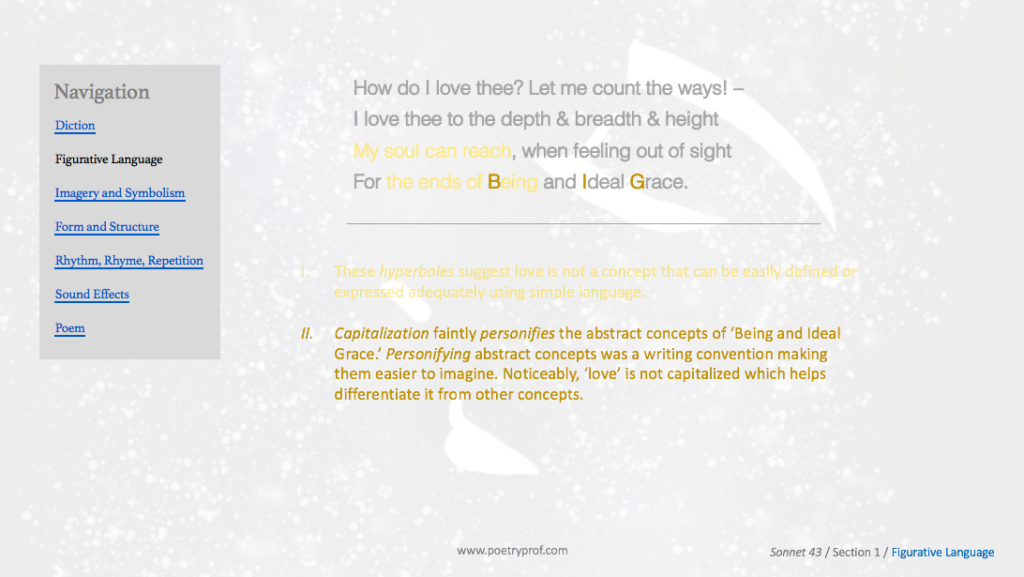



Sonnet 43 Poetry Prof
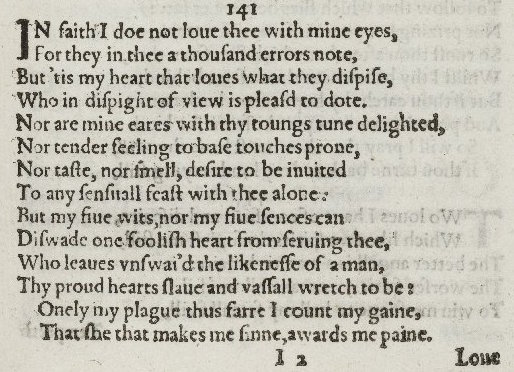



Sonnet 141 Wikipedia
· How Do I Love Thee?Is sonnet number 43 taken from The Sonnets From the Portuguese, not writing poems about love The second,third and fourth lines suggest that her love is all encompassing, stretching to the limits, even when she feels that her existence Being and God's divine help Grace might end, it's the love she has for her husband Robert that will– and, if God choose, I shall but love thee better after death" Browning ends the poem with a couplet and the rhyme scheme of 14 lines and "abab" pattern, which is similar to the traditional Shakespearean sonnet
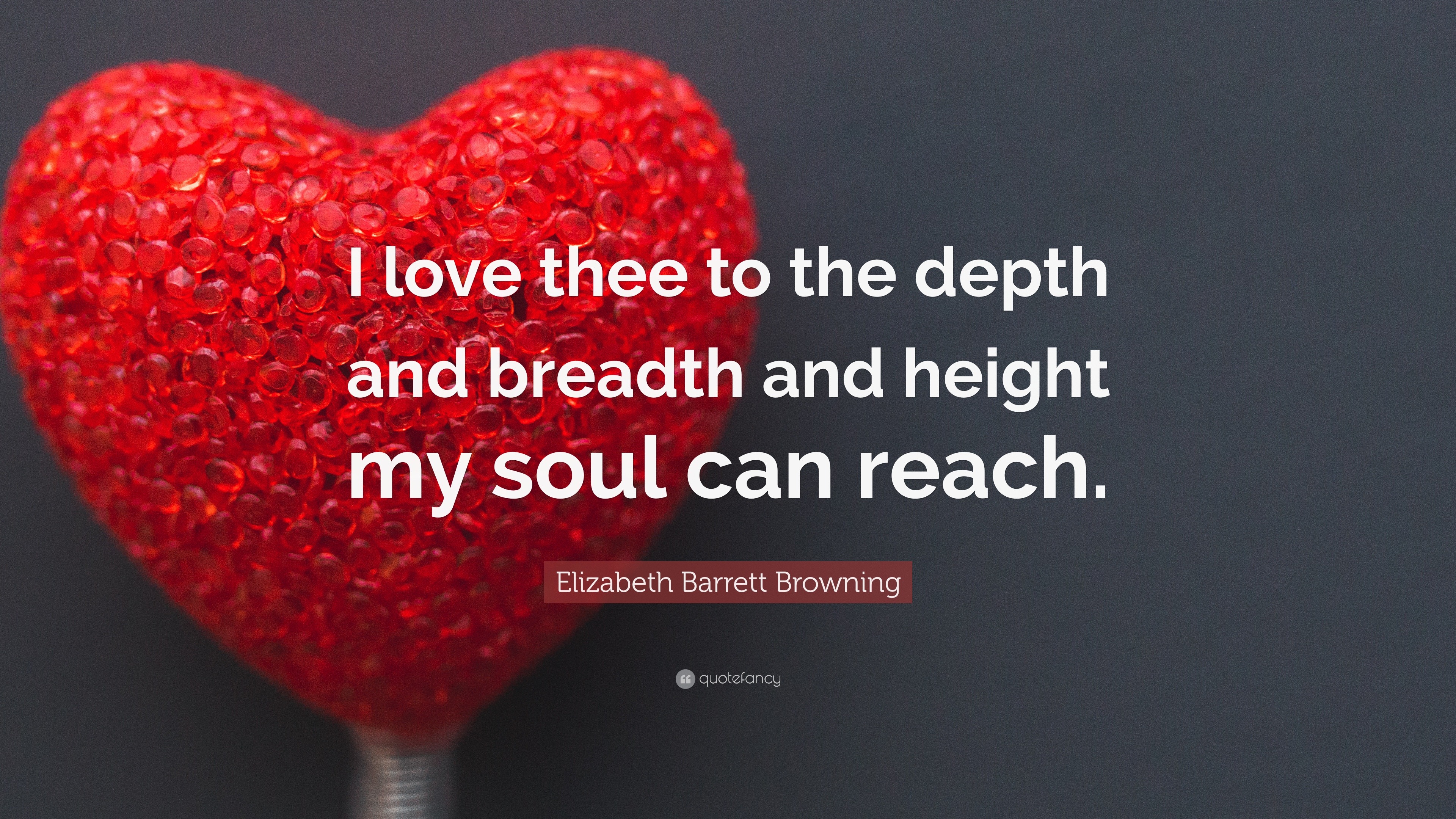



Elizabeth Barrett Browning Quote I Love Thee To The Depth And Breadth And Height My Soul
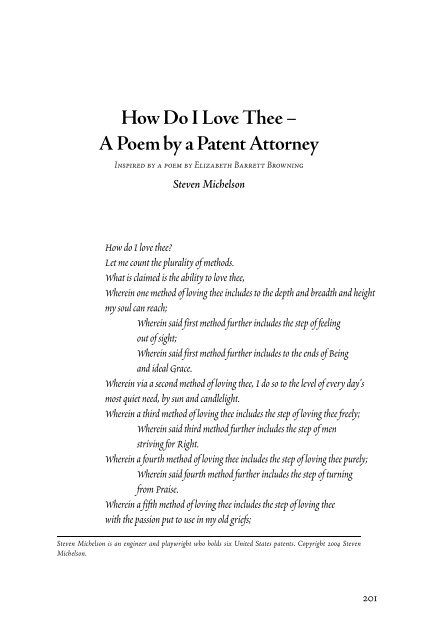



How Do I Love Thee A Poem By A Patent Attorney The Green Bag
Do I Love Thee Poem Analysis 781 Words 4 Pages How Do I Love Thee – Elizabeth Barrett Browning interprets the meaning, tone, and overall effect of a poem How Do I Love Thee by Elizabeth Barret Browning is an iconic and powerful love poem The work is part of Sonnets from the Portuguese, a collection of poems that Elizabeth Browning wrote · The love poem ends with the declaration that time and death will not diminish her love for Robert because "if God choose, I shall but love thee better after death " Repetition – The repetition of "How do I Love Thee" emphasizes the intensity of the speaker's love Theme – The poem's theme can be found in the final six lines True love overcomes all and is eternal in natureThe question that opens the poem—"How do I love thee?"—is an example of aporia, the expression of real or pretended doubt in order to make a point Browning employs aporia as a rhetorical device to emphasize the intensity of love that
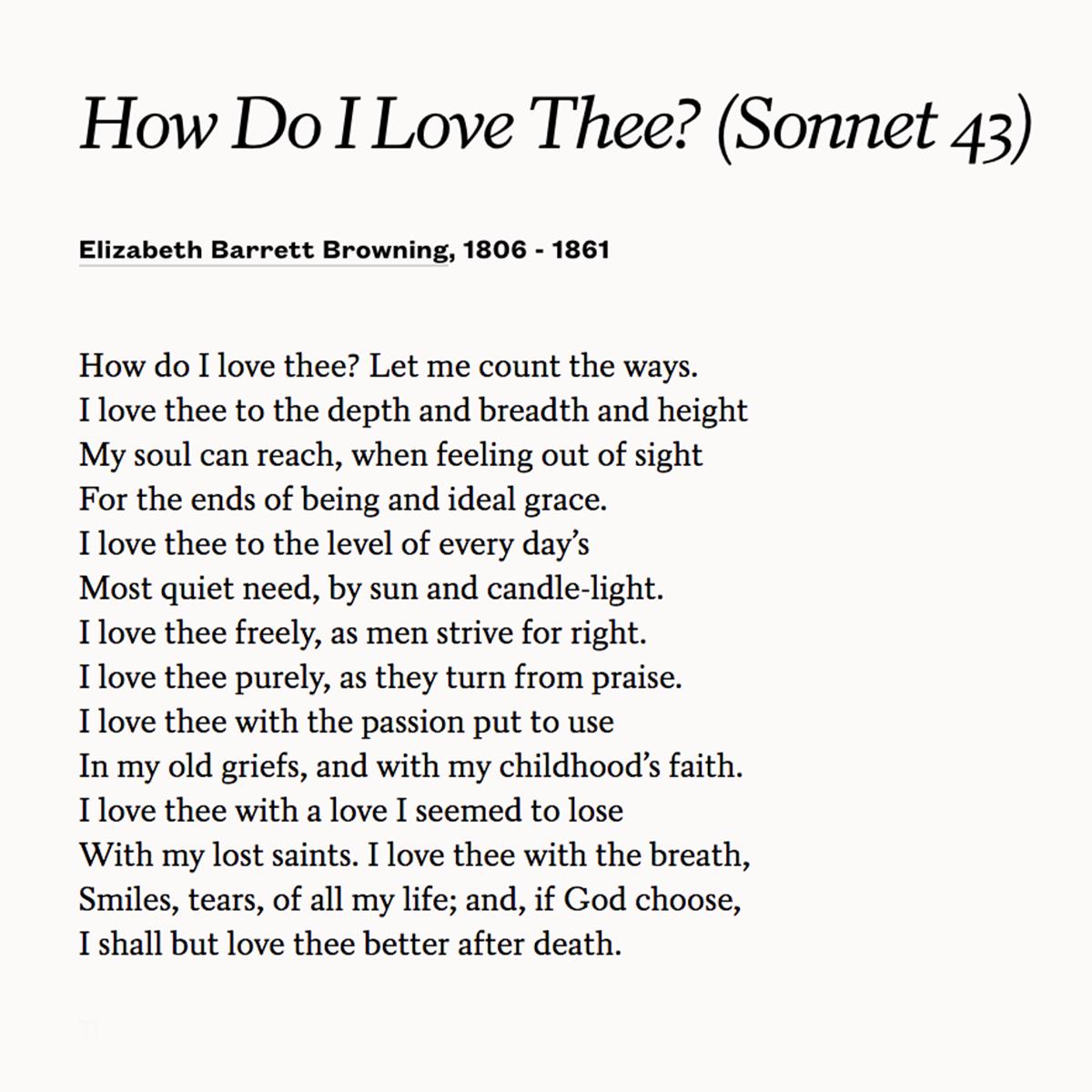



Poets Org How Do I Love Thee Let Me Count The Ways Elizabeth Barrett Browning Born Otd In 1806 Womenshistorymonth T Co Lcdo1k4oym T Co Wjndzrnzow
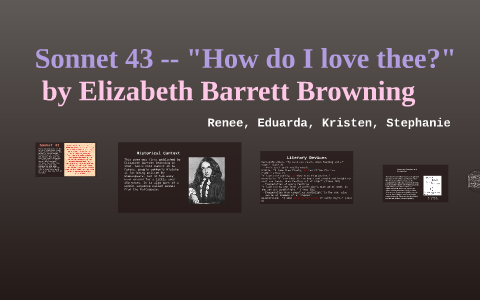



Sonnet 43 By Renee Staude
Let me count the ways" or "How do I love thee?" for short And that pretty much says it all the poem is a list of ways that the speaker loves her beloved It's interesting to notice the way that the poet balances this list structure with a traditional sonnet structure, which requires a'How Do I Love Thee' is a famous love poem and was first published in a collection, Sonnets from the Portuguese in 1850 The poem deals with the speaker's passionate adoration of her beloved with vivid pictures of her eternal bond that will keep her connected to her beloved even after death One may also ask, what does Sonnet 43 mean?The poem is a sonnet, a 14line poem written in iambic pentameter Although it does not follow the precise rhyme scheme of an Italian sonnet, the poem's structure follow the form of an Italian sonnet, consisting of an octet – the first eight lines, and the sestet, the final six lines How Do I Love Thee When was it written?




Essay About How Do I Love Thee Poem




How Do I Love Thee Poem Save The Date Photo Card Save The Date Cards
The poem How Do I Love Thee? · This is the traditional pattern of a Petrarchan sonnet, one of the two major sonnet forms (The other is the Shakespearean sonnet which rhymes ABABCDCDEFEFGG)The poem also makes use of the usual metrical pattern associated with standard sonnet forms, that is, iambic pentameter this means that each line contains five sets of two beats"How Do I Love Thee?




How Do I Love Thee Sonnet 43 National Poetry Day




Analysing Elizabeth Barrett Browning S Sonnet 43 Part One Dystopiajunkie Analysis Youtube
· This structural form is none like any of the other poems I am analysing In the poem 'How Do I Love Thee' the language in this is very important because Elizabeth keeps reusing the phrase 'I love thee' almost echoing it throughout the whole poem making it a very effective phrase In the language she uses an element of religion to communicate the meaning of the poem · The author starts the poem by asking the question, "How do I love thee?" and responding with, "Let me count the ways" One might assume that the speaker is either musing out loud – as one might do when writing a letter – or responding to a lover who might have presented such a question'How do I love thee




Pin On Me




Elizabeth Barrett Browning How Do I Love Thee How Do I Love Thee Let Me Count The Ways I Love Thee To The Depth And Breadth And Height My Soul
Is a portion of a sonnet sequence called Sonnets from the Portuguese Barrett Browning implied to Elizabeth's readers that she had translated the sonnets, which were originally written by someone in Portuguese ButI love thee purely, as they turn from praise I love thee with the passion put to use · Sonnet 43, also known as "How Do I Love Thee" is a literary classic written by Elizabeth Barrett Browning in 1850This poem follows a Petrarch sonnet structure, even though she lived closer to Shakespear's time This poem explores all the ways the author loves someone, it even goes through almost all stages of life Her love is talked about on an everyday level, as well



How Do I Love Thee Poem




How Do I Love Thee Let Me Count The Ways Sonnets From The Portuguese 43 Poem Summary And Analysis Litcharts
Major Themes in How Do I Love Thee Love and faith are the major themes filling this poem The poem is primarily concerned with the love of the speaker with her significant other She expresses her deep and innocent love in captivating ways Who was how do I love thee written for?The first word (here it's "iambic") tells you what kind of "foot," or small unit of rhythm, is the main one in the poem The second word (here it's "pentameter") tells you how many of those feet are put together to make one line An "iamb" is a twobeat foot that goes "daDUM" – one unstressed syllable followed by one stressed syllableLearn how the choice of words and phrases in a poem impacts the overall meaning and tone In this interactive tutorial you'll examine Sonnet 43, "How Do I Love Thee?" by Elizabeth Barrett Browning and engage in a critical analysis of the language, reflect on your own interpretations, and write about what you have learned
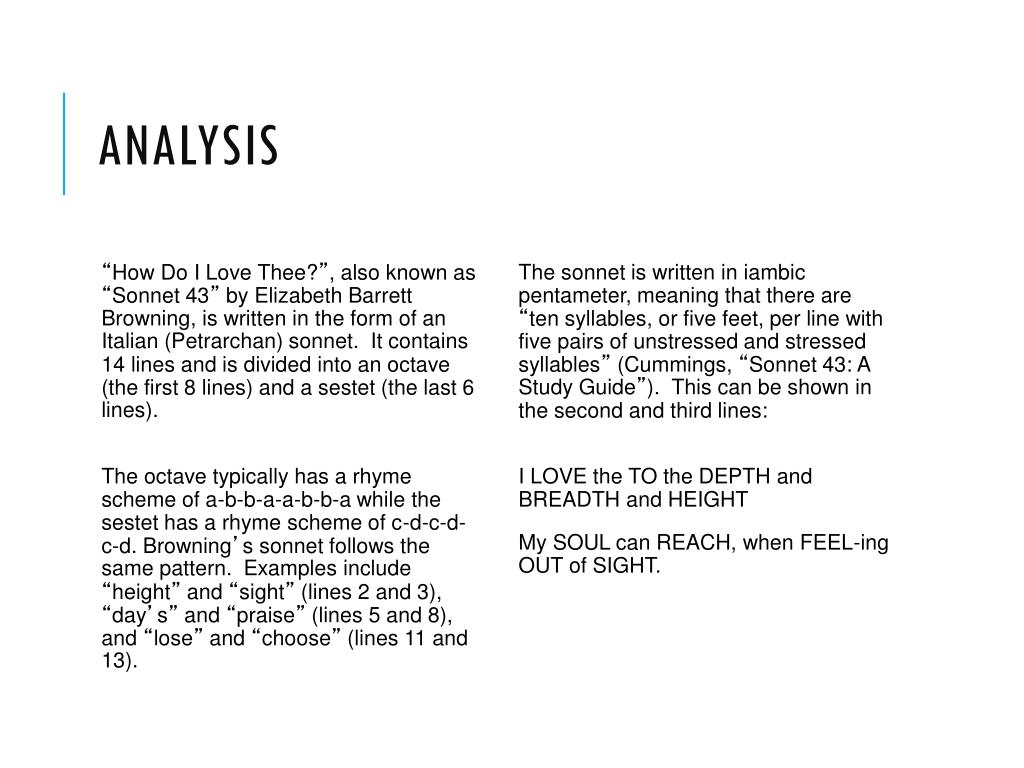



Ppt Elizabeth Barrett Browning Powerpoint Presentation Free Download Id
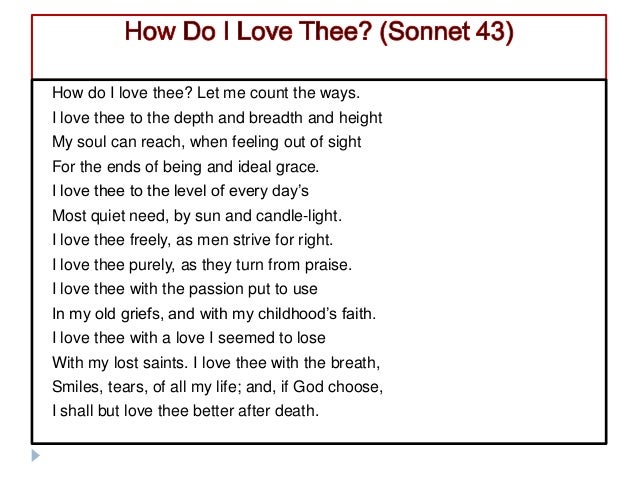



Sonnet 43 How Do I Love Thee By Elizabeth Barrette Browning
Let me count the ways I love thee to the depth and breadth and height My soul can reach, when feeling out of sight For the ends of being and ideal grace I love thee to the level of every day's Most quiet need, by sun and candlelight I love thee freely, as men strive for right; · The sonnet is a compact and demanding form You have very few words to convey your vision After the opening line, and a general statement about the immensity of her love, she spends more than halfMost critics agree that Barrett




10 Best Love Poems Ever Writer S Digest
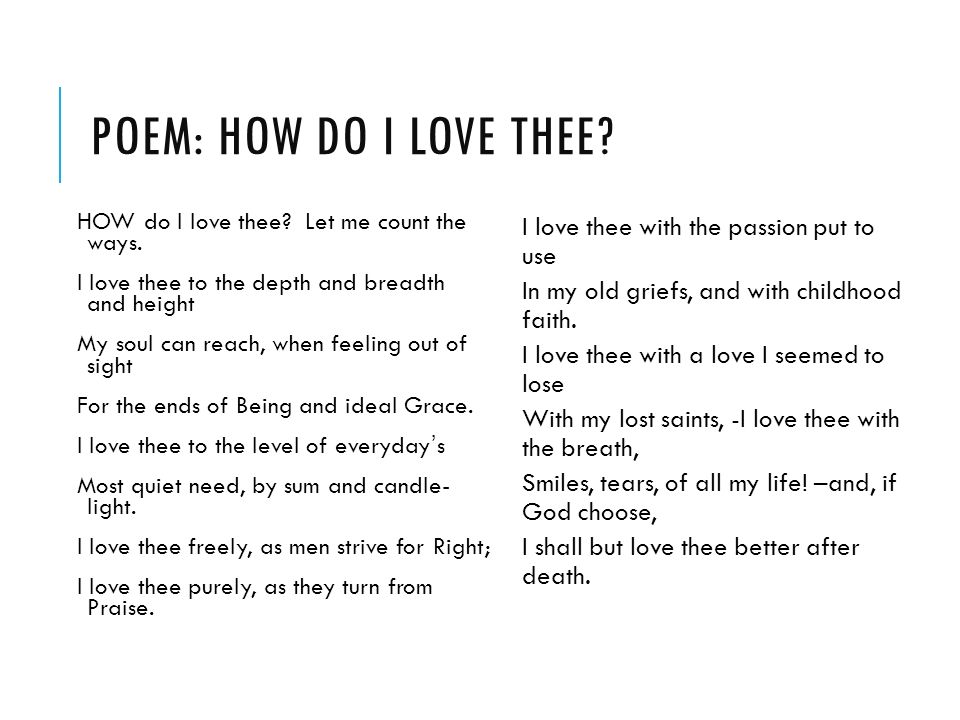



Elizabeth Barrett Browning Ppt Video Online Download
Fare Thee Well Fare Thee Well may refer to "Fare Thee Well" (poem), an 1816 poem by Lord Byron "Fare Thee Well" (song), an English folk ballad "Dink's Song", or "Fare Thee (disambiguation) Thee is an archaic form of 'you' Thee may also refer to Thee (1981 film), Tamil film about two brothers one a policeman, the other a smuggler TheeThis booklet includes a set of notes about the title, structure and language of the poem 'How Do I Love Thee?' by Elizabeth Barrett Browning Suitable for those studying English Literature at GCSE as a useful revision aid for the Edexcel Relationships poetry anthology




How Do I Love Thee Sonnets Poetry




How Do I Love Thee Poem By Elizabeth Barrett Browning Sonnet 43 Youtube




How Do I Love Thee Love Poem By Elizabeth Barrett Browning Love Poems Love Quotes Love Quotes For Him



How Do I Love Thee Gcse English Marked By Teachers Com



How Do I Love Thee Sonnet 43 National Poetry Day




Sonnet Poetry Form Art Print Jeanne Stevenson Art Com Forms Of Poetry Poetry Posters Poetry For Kids




How Do I Love Thee Sonnets Poetry
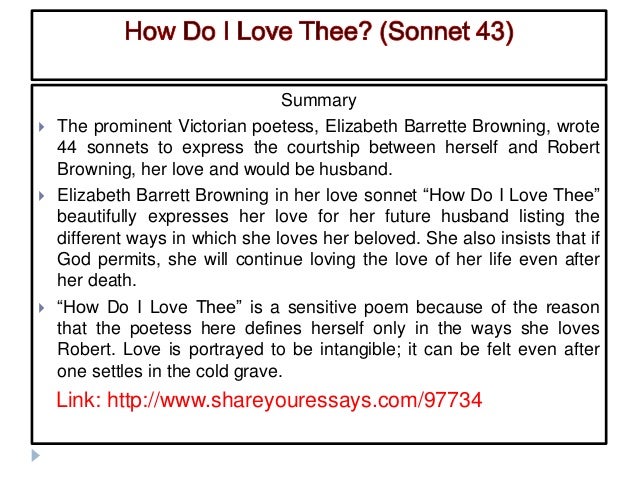



Sonnet 43 How Do I Love Thee By Elizabeth Barrette Browning
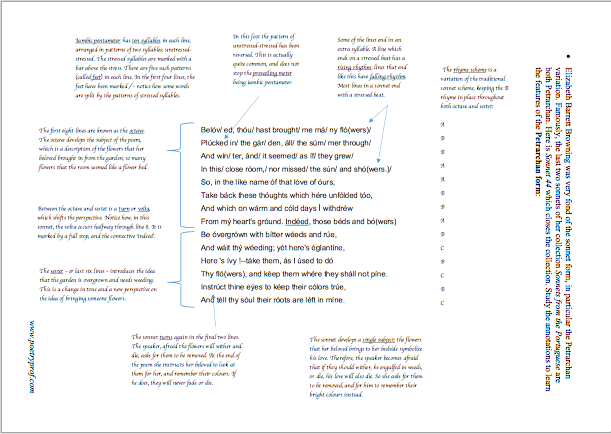



Sonnet 43 Poetry Prof
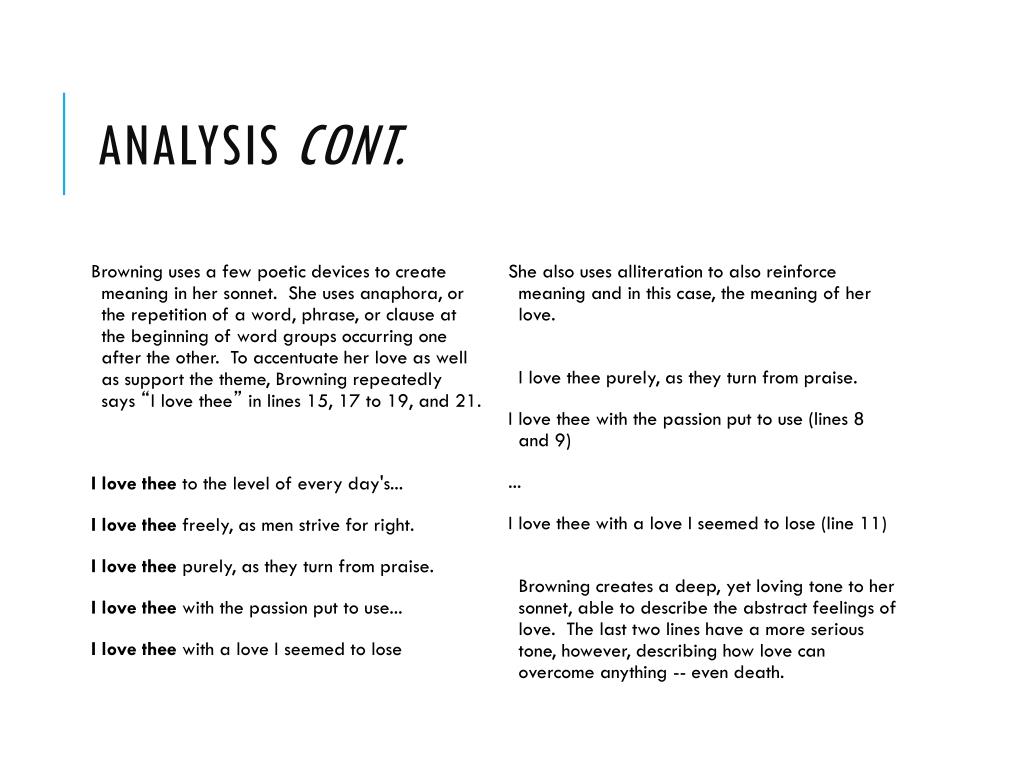



Ppt Elizabeth Barrett Browning Powerpoint Presentation Free Download Id




If Thou Must Love Me Let It Be For Nought Sonnets From The Portuguese 14 Poem Summary And Analysis Litcharts




An Analysis Of How Do I Love Thee By Elizabeth Barret Browning One Of The World S Most Famous Love Poems Brighthub Education
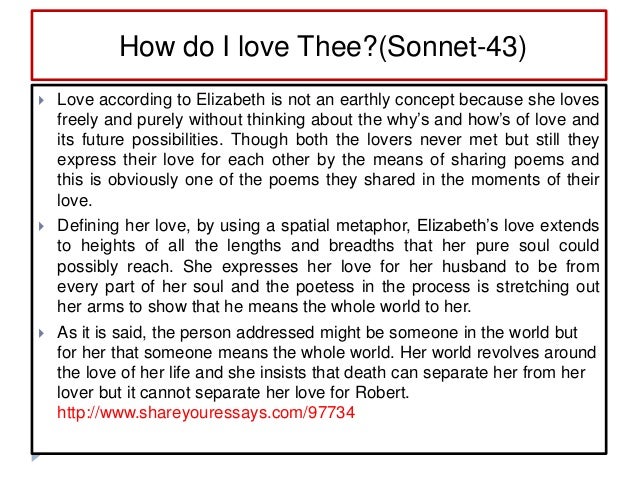



Sonnet 43 How Do I Love Thee By Elizabeth Barrette Browning
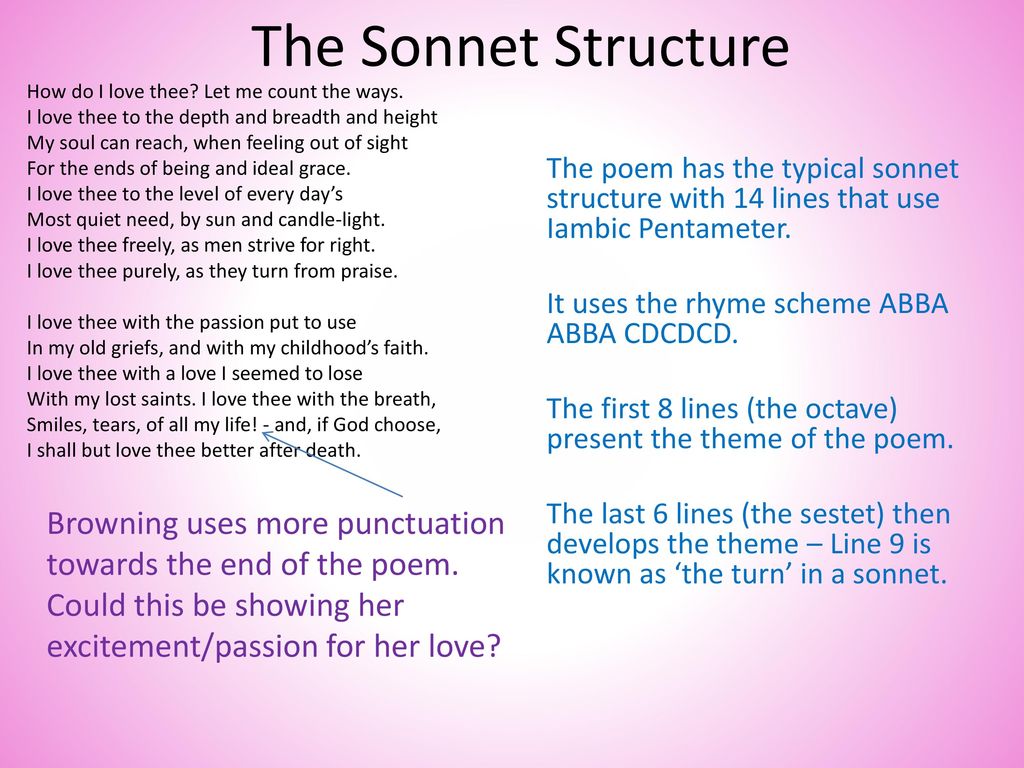



Sonnet 43 Elizabeth Barrett Browning Ppt Download




Analysis Of Poem How Do I Love Thee By Elizabeth Barrett Browning Owlcation




New Tricks Sonnets How Do I Love Thee With Ashley Hickson Lovence The Book Hive




From Published Poetry
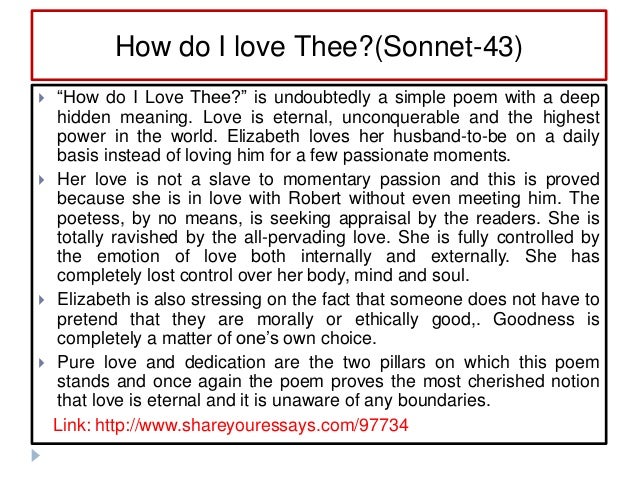



Sonnet 43 How Do I Love Thee By Elizabeth Barrette Browning
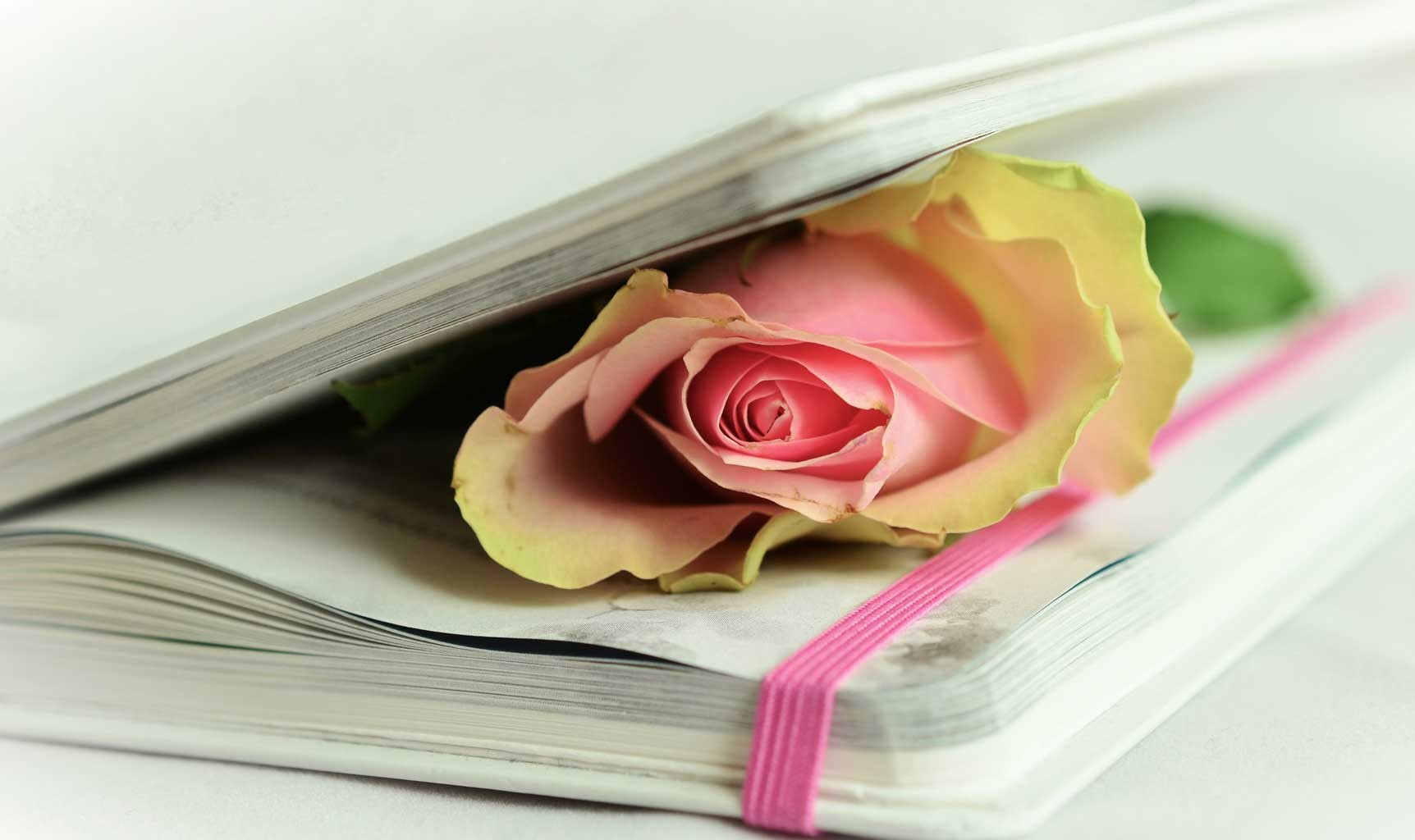



How Do I Love Thee Sonnet 43 By Elizabeth Barrett Browning Famous Love Poem
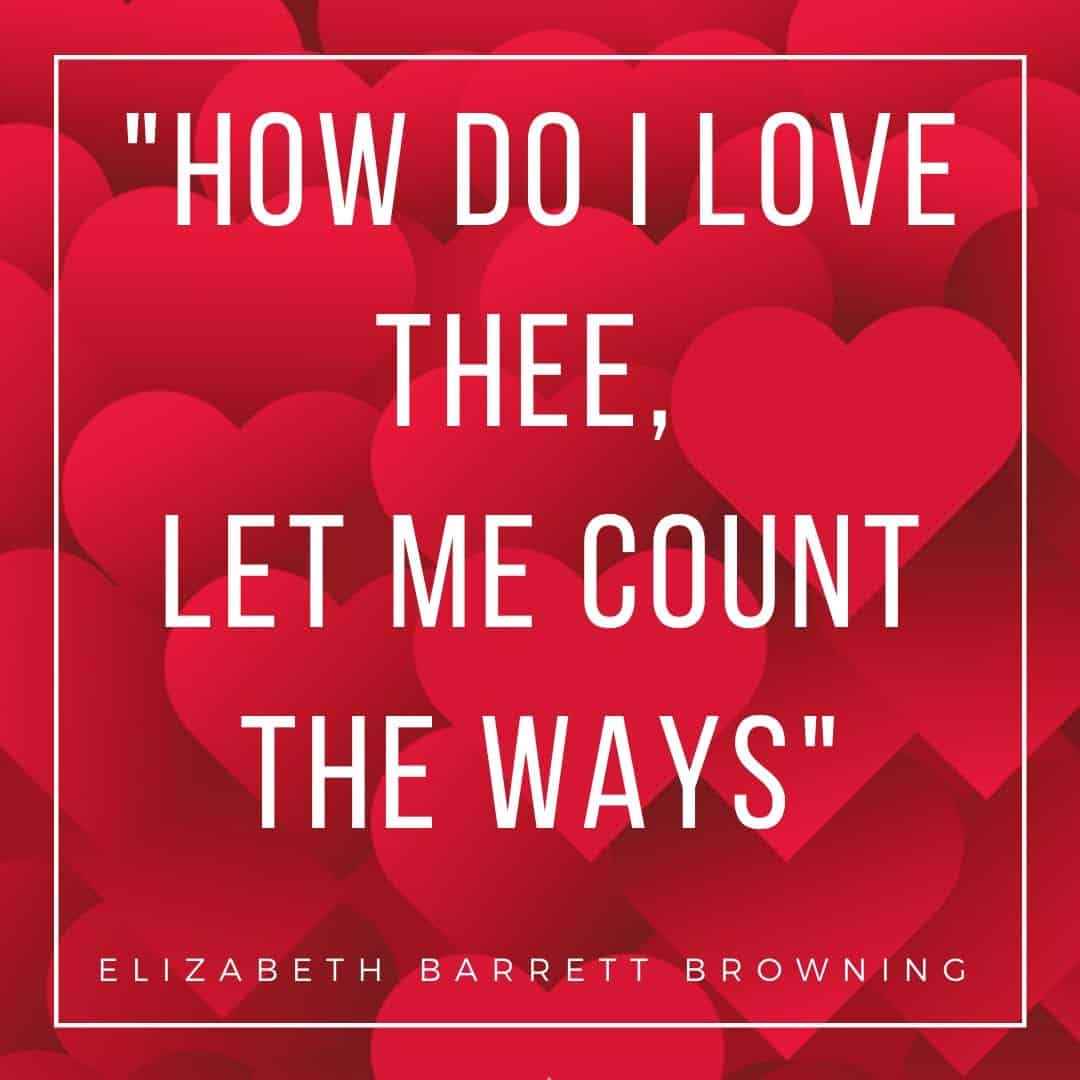



How Do I Love Thee Let Me Count The Ways Sonnet Analysis



Analysis Of How Do I Love Thee By Elizabeth Barret Browning Gcse English Marked By Teachers Com




Sonnet 43 Poetry Prof




Romantic Poetry The Best Romantic Poems Of All Time




10 Sonnets Examples Of Sonnets Sonnet Poems




A Blog Of One S Own How Do I Love Thee Let Me Count The Poems




Sonnet 43 How Do I Love Thee By Elizabeth Barrette Browning




Sonnet 43
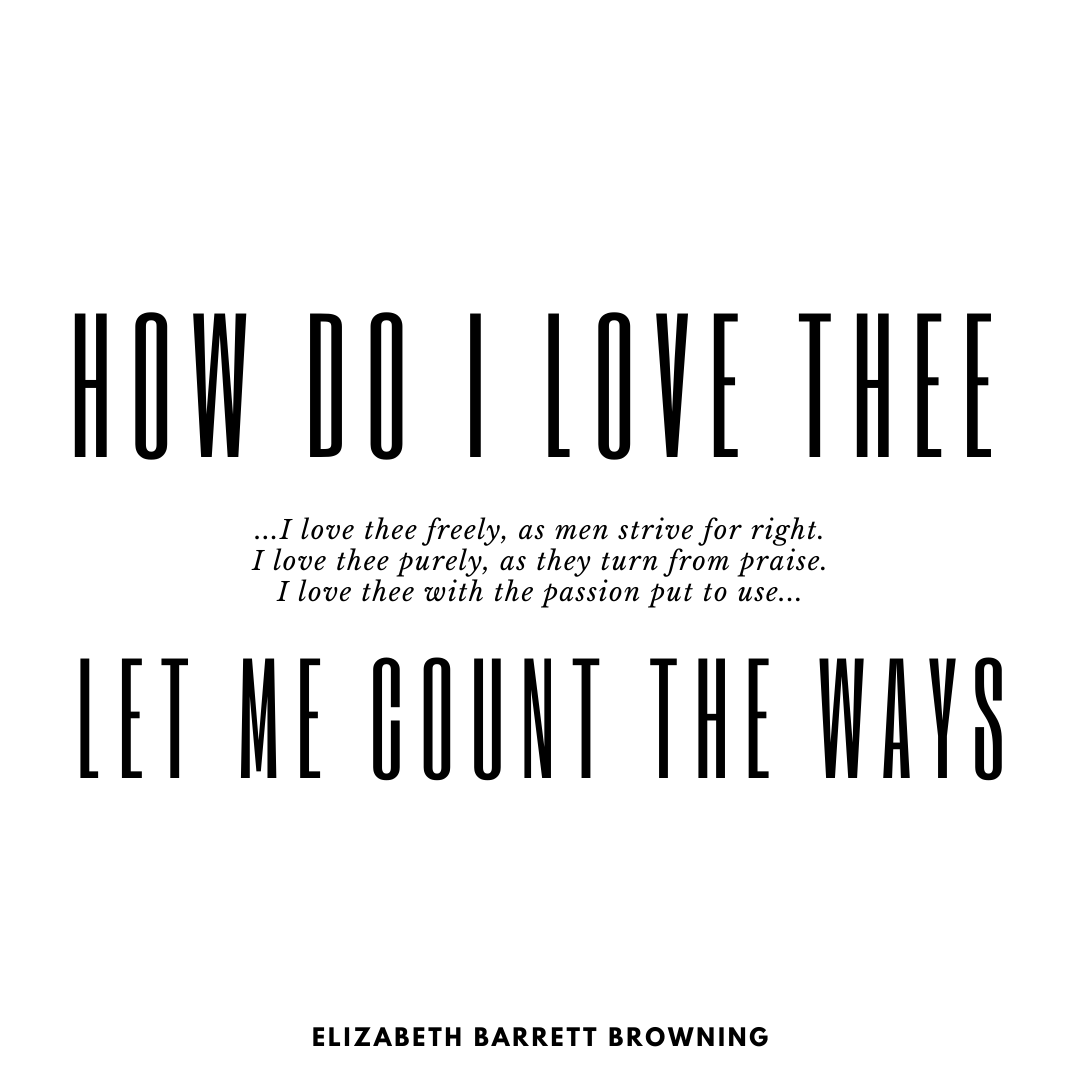



What We Can Learn From A Victorian Poet S Life Choices
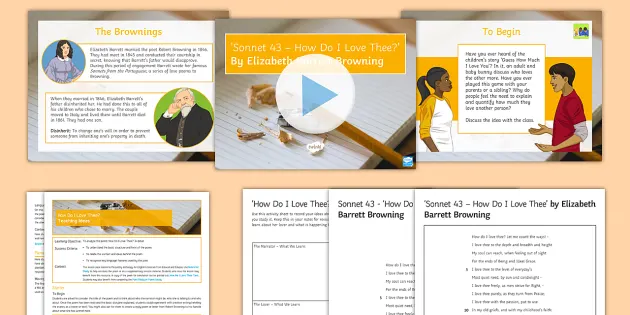



Gcse Poetry Lesson Pack Sonnet 43 By Barrett Browning




How Do I Love Thee




How Do I Love Thee Let Me Count The Ways Sonnets From The Portuguese 43 Poem Summary And Analysis Litcharts




Manuscript Of Elizabeth Barrett Browning S How Do I Love Thee The British Library




Pin On Life
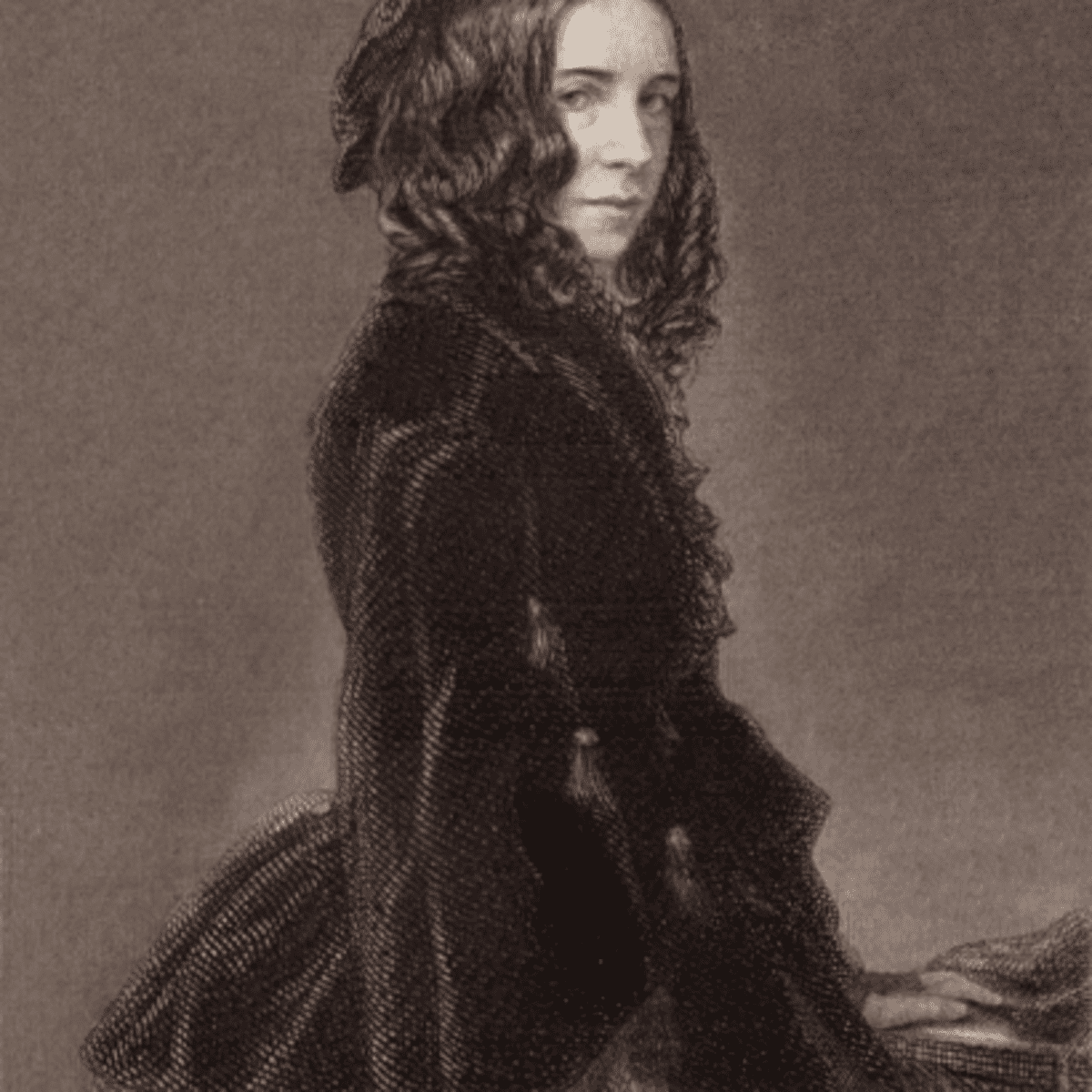



Analysis Of Poem How Do I Love Thee By Elizabeth Barrett Browning Owlcation
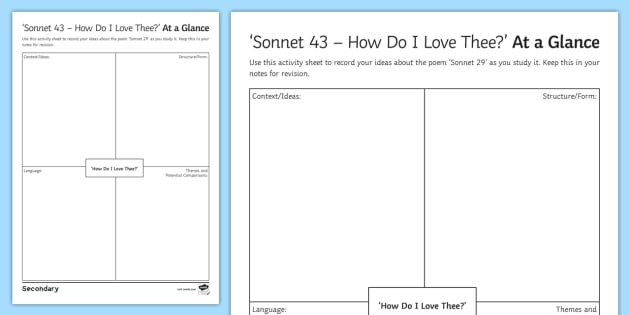



Gcse Poetry At A Glance Worksheet Worksheet To Support Teaching On Sonnet




Elizabeth Barrett Browning Wikipedia
/what-is-a-sonnet-2985266_FINAL-5c92a9d446e0fb0001376e7d.png)



What Is A Sonnet Overview And Characteristics




How Do I Love Thee Sonnet 43 By Elizabeth Barrett Browning Poems Poets Org




Sonnet 43 How Do I Love Thee




How Do I Love Thee




A Short Analysis Of Elizabeth Barrett Browning S How Do I Love Thee Let Me Count The Ways Interesting Literature




Sonnet 43 How Do I Love Thee Elizabeth Barrett Browning Teaching Resources




A Short Analysis Of Elizabeth Barrett Browning S How Do I Love Thee Let Me Count The Ways Interesting Literature
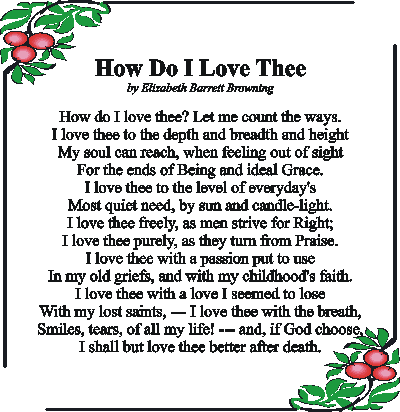



Analysis Of How Do I Love Thee By Elizabeth Barrett Browning Beaming Notes




How Do I Love Thee Sonnet 43 National Poetry Day




How Do I Love Thee Let Me Count The Ways Sonnets From The Portuguese 43 Poem Summary And Analysis Litcharts




Sonnet 43 How Do I Love Thee Let Me Count Poem Analysis



Analysis Of How Do I Love Thee By Elizabeth Barret Browning Gcse English Marked By Teachers Com
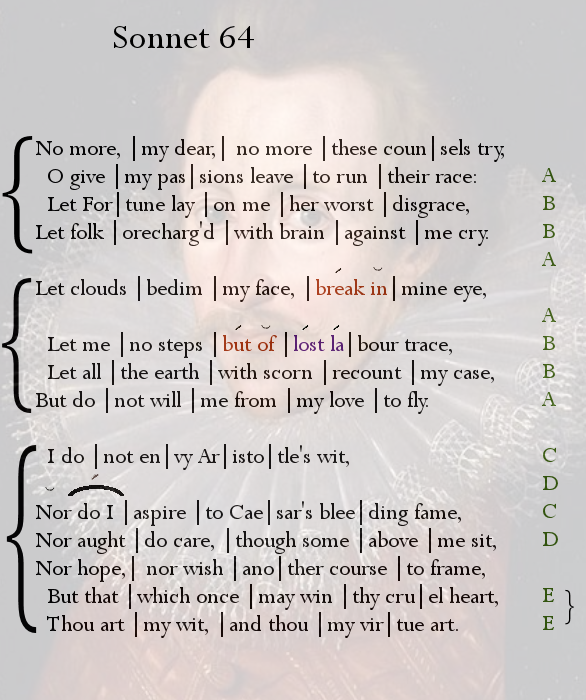



Sir Philip Sidney Poemshape
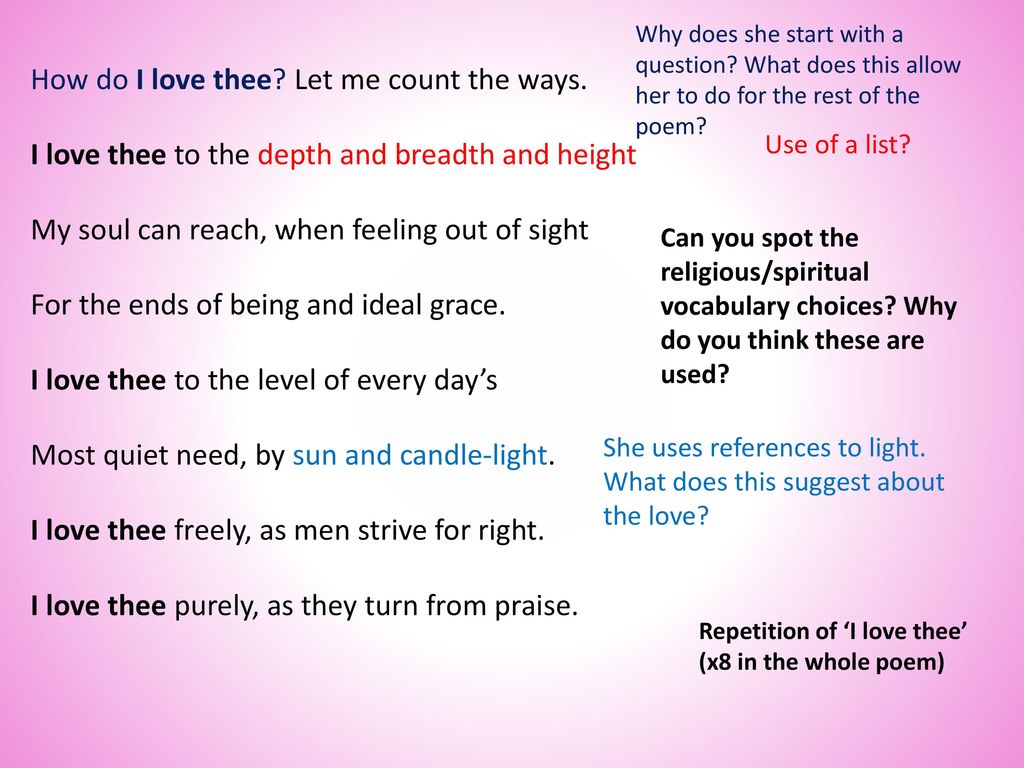



Sonnet 43 Elizabeth Barrett Browning Ppt Download
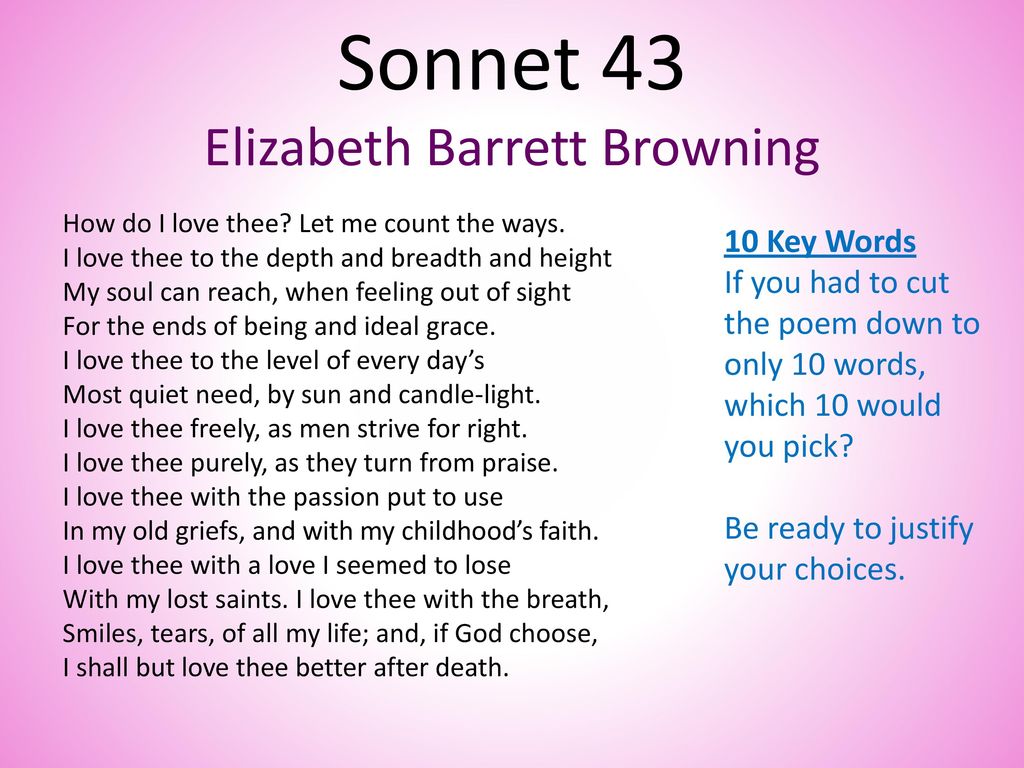



Sonnet 43 Elizabeth Barrett Browning Ppt Download




How Do I Love Thee By Elizabeth Barrett Browning Read By Tom O Bedlam Youtube
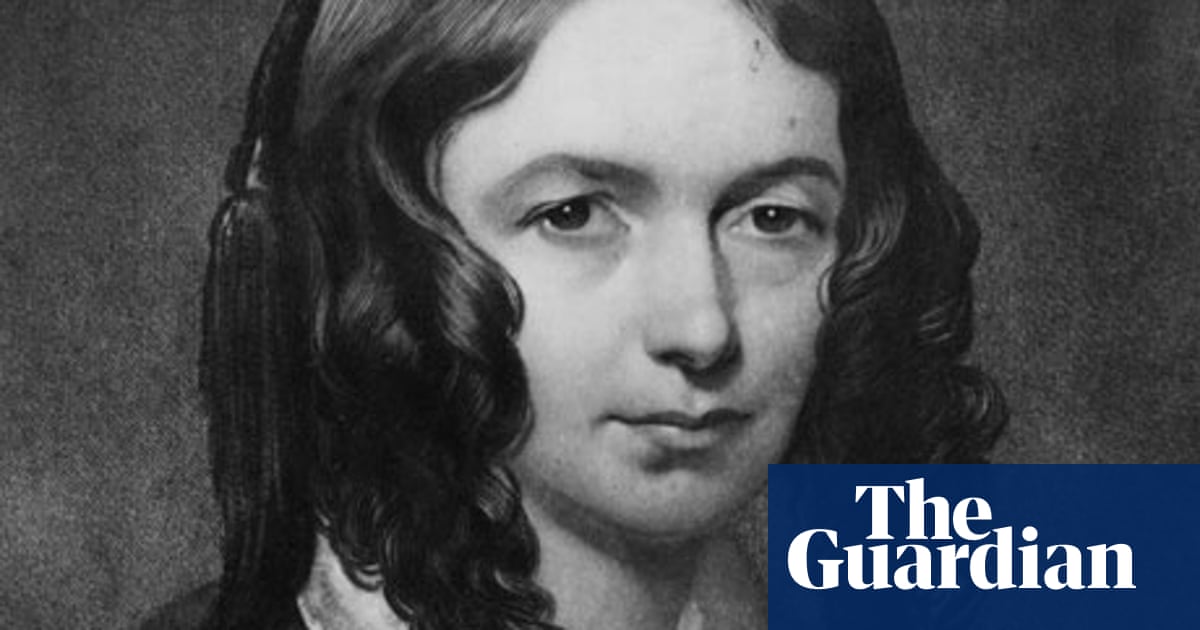



Poem Of The Week Sonnets From The Portuguese No 43 By Elizabeth Barrett Browning Poetry The Guardian
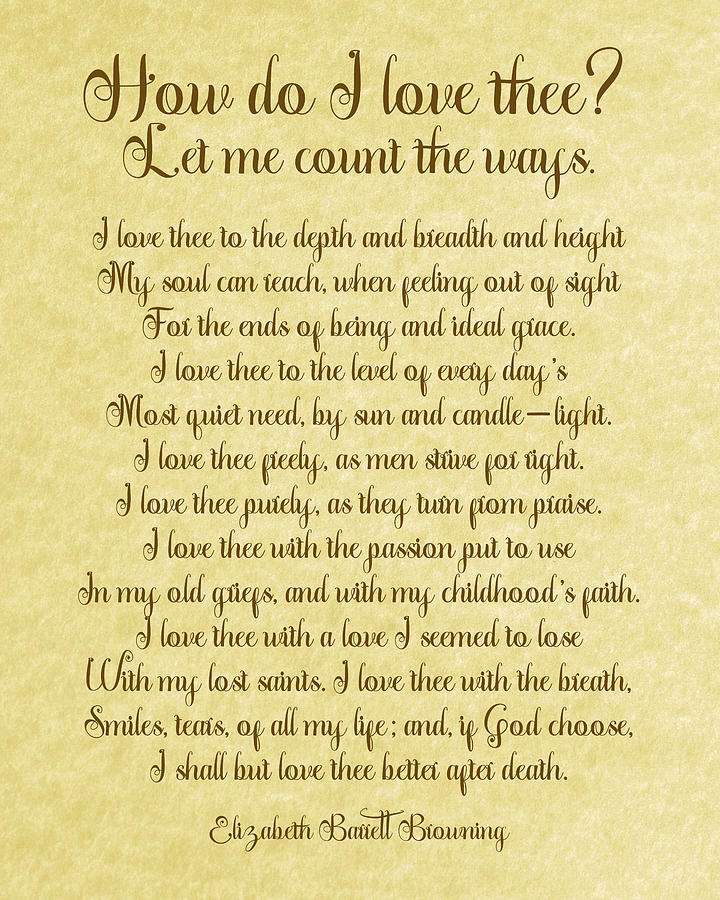



How Do I Love Thee Poem Buff Parchment Digital Art By Ginny Gaura




A True Love Story Elizabeth Barrett Browning Robert Browning Smic English 12 Regular Ppt Download
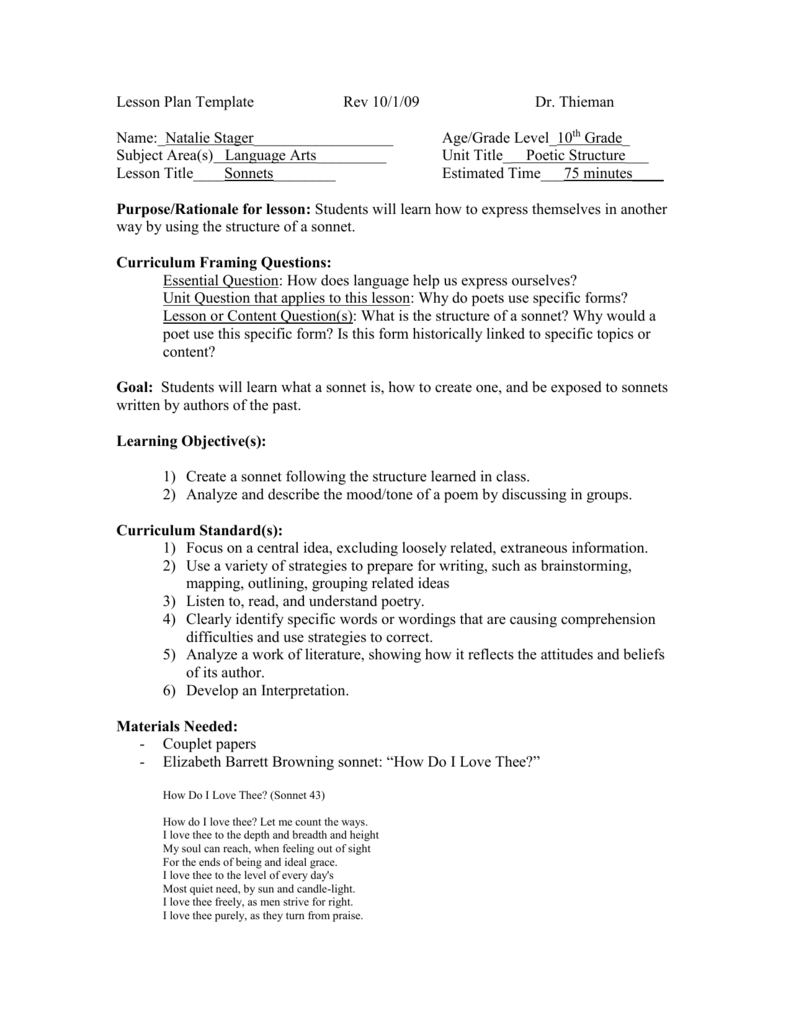



Lesson Plan Template




Identifying Forms In English Poetry Video Lesson Transcript Study Com




How Do I Love Thee By Gabriela Dealmeida
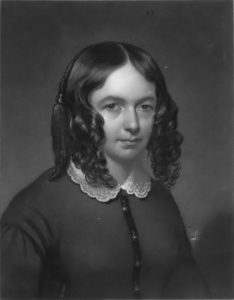



How Do I Love Thee By Elizabeth Barrett Browning Sonnet Composition And Literature




Poems Sean O Vista




How Do I Love Thee Sonnet 43 By Elizabeth Barrett Browning English Language And Literature




Page Modern Poets And Poetry Of Spain Djvu 181 Wikisource The Free Online Library



0 件のコメント:
コメントを投稿